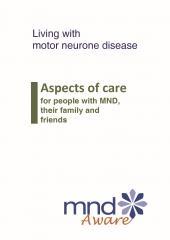48 page A4 book providing an overview of motor neurone disease and strategies for symptom management.
- View free online Living with motor neurone disease: aspects of care for people with MND, their family and friends
- Hardcopy available - free for members in NSW, ACT and NT; small fee for others.
Topics covered:
What is motor neurone disease?
Neurones
First signs and symptoms
Classification into types
Effect of MND
How do people get MND?
Incidence and prevalence
MND progression
Living with MND
Wellbeing and support needs
Information needs
Psychological and spiritual needs
Planning needs
Daily living and mobility needs
Personal care, home care and respite care needs
Financial needs
Multidisciplinary care and MND
Regular medical review
Living better for longer
Multidisciplinary care
Breathing
Signs and symptoms of respiratory muscle weakness
Approach to management
Strategies for managing respiratory muscle weakness and sensations of breathlessness
Swallowing and nutrition
Muscle weakness and swallowing
Swallowing difficulties in MND
Approach to management
Strategies for managing swallowing difficulties
Saliva and mouth care
Mouth care, teeth care and MND
Drooling saliva
Thick saliva
Dry mouth
Communication
Signs and symptoms of weakness in the muscles involved in communication
Approach to management
Getting communication aids and devices
Movement and joints
Neck, upper limb and lower limb muscle weakness
Approach to management
Strategies for managing neck, upper and lower limb muscle weakness
Getting aids and equipment
Fatigue and insomnia
Reasons for fatigue
Strategies for managing fatigue
Reasons for insomnia
Strategies for managing insomnia
Bladder and bowel
Bladder and bowel difficulties in MND
Approach to management
General toileting tips
Bladder management
Bowel management
Cognition
What do changes in cognition and behaviour look like?
Strategies for managing cognitive and behavioural change
Emotional lability
Emotional lability and MND
Effects of emotional lability
Strategies for emotional lability
Care in the later stages of MND
Palliative care
Fears and questions about death
The end phase
Publication update
MND NSW is currently in the process of updating this publication to include the following information about Voluntary Assisted Dying (VAD) which has been adapted from the MND Australia Planning Ahead Fact Sheet, updated July 2024
Voluntary Assisted Dying (VAD) is one choice available to eligible people at end of life. A person may access palliative care and VAD at the same time.
With VAD, a person in the late stages of advanced disease chooses to end their life with medical assistance. VAD is currently legally available in New South Wales, Queensland, South Australia, Tasmania, Victoria and Western Australia, with strict eligibility criteria. This means people with MND may have access to VAD, should they wish to pursue it.
The eligibility criteria and process for VAD differs slightly from state to state. If you are thinking about VAD, or would like more information, ask your doctor or healthcare team about it. In some states, doctors or healthcare providers may not be legally allowed to start a conversation about VAD, so you may need to raise the topic.


